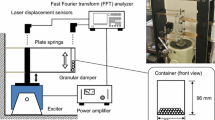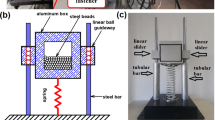Abstract
Particle dampers are increasingly popular in the application of seismic engineering. Vibration suppression and energy dissipation are achieved with the interactive impact of granular particles embedded within their containers. The combined finite-discrete element method (FEM /DEM ) is employed in the simulation of particle dampers in this paper. Two key impact mechanisms are addressed: the particle-wall impact and particle-particle impact. A simple example is given, showing that structures with particle dampers are more capable of absorbing energy than their counterpart with an equivalent mass. Numerical results prove that the FEM /DEM is applicable and reliable in analysing particle damping systems.
Access provided by CONRICYT-eBooks. Download conference paper PDF
Similar content being viewed by others
Keywords
These keywords were added by machine and not by the authors. This process is experimental and the keywords may be updated as the learning algorithm improves.
1 Introduction
Among the passive structural control strategies, nonlinear particle dampers offer great advantages in reducing vibration amplitude and absorbing energy without any power input. Momentum is transferred and internal energy is dissipated simultaneously with the interactive impacts between solid particles. Many experimental [1–3] and numerical [4–6] endeavours were made to investigate the characterisation of particle dampers. Although the above-mentioned experimental and numerical models gave many new insights on the performance of particle dampers, most of them are phenomenological and difficult to extrapolate respective conditions. Since the behaviour of particle dampers are highly discontinua, the discrete element method (DEM ) is the best approach.
In this paper, the combine finite-discrete element method (FEM /DEM ) [7] is employed to simulate the behaviour of particle dampers. The FEM /DEM is a branch of the DEM family, and aims at solving transient dynamics of solid mechanics with the consideration of both continua and discontinua. In the analysis, particles are fully discretised into a number of individual triangular discrete elements, and each discrete element interacts with those that are in contact with it. Within a single discrete element, finite element mesh is formulated, leading to a more accurate estimate of contact force, stress and deformation. Each particle, usually of a spherical shape, is considered unable to fracture. Deformation and stress of particles are represented by the FEM while contact forces and motions are governed by the DEM .
It is the first time that the FEM /DEM is used to simulate the behaviour of particle dampers. Two key interactive impact mechanisms of particle damping systems are taken into account in this paper: particle-wall impact and particle-particle impact. The particle-wall impact is addressed through a free-fall simulation and the particle-particle impact is discussed in a packing modelling. A simple example is given and conclusions are reached that the FEM /DEM is capable of capturing the behaviour of particle dampers.
2 Particle-Wall Impact
In this section, a free-fall steel ball (particle) hitting a fixed steel plate (wall) under gravity (Fig. 1) is simulated by the combined FEM /DEM to address the particle-wall interactive impact mechanism.
The ball is 0.05 m in radius and 0.1 m high above the top surface of the plate. The plate is 1.0 m × 0.1 m and completely fixed in space. There are 96 elements in the ball and 80 elements in the plate. The surface of the ball is meshed with fine elements so that a circular shape can be guaranteed. Time step for this simulation is 10 ns. In this analysis, any fracture within the ball or the plate will not be considered, and so that this is a pure elastic problem. Density of steel is 7800 kg/m3, Young’s modulus is 200 GPa and Poisson’s ratio is 0.3.
Figure 2 shows the change of the vertical displacement and velocity of the centre of the ball along with time. It can be observed that both the maximum displacement and velocity decay with the increase of time, suggesting that energy is gradually dissipated during the multiple impacts between the ball and the plate driven by gravity. The energy dissipation during multi-impacts demonstrates that free-fall simulation by the FEM /DEM is more realistic than the study of Lu et al. [8].
The ball finally rests on the plate after t = 1.75 s. Since only the acceleration of gravity g = 9.8 m/s2 is applied, the analytical travel distance should be of parabolic, which is shown in Fig. 2. The initial free-fall distance is 0.1 m, and consequently the first contact time occurs at t = 0.143 s. At this time point, the vertical velocity of the ball should be v = 1.4 m/s analytically. In the simulated result, it is obtained as v = 1.3965 m/s, which is very close to the analytical solution. These show that the FEM /DEM is capable of simulating the free-fall behaviour under gravity precisely, and further demonstrate that the particle-wall impact mechanism is well captured.
3 Particle-Particle Impact
A packing simulation is conducted to show the effectiveness of FEM /DEM simulation of both particle-particle and particle-wall impact. Consider a fixed rectangular cavity with the outer and inner dimensions 1.0 m × 1.6 m and 0.9 m × 1.5 m, respectively. 51 balls with the radius of 0.05 m are randomly distributed over the cavity.
The cavity is fixed and balls are placed freely without any restriction. The cavity is composed of 800 elements with the characteristic size of 25 mm, while 3270 elements with the characteristic size of 15 mm are meshed to the balls in total. Time step is 100 ns. Both the balls and the cavity are made of steel, where material properties can be referred to Sect. 2. Acceleration of gravity g = 9.8 m/s2 is applied to the balls. Figure 3 presents the selected frames of the FEM /DEM simulation for the above-mentioned packing under gravity.
It can be observed from Fig. 3 that balls fall under the gravity and gradually pack themselves at the bottom of the cavity. The packing process is almost finished at t = 1.0 s and the final positions of the balls are reached at t = 2.0 s. Figure 4 gives the change of the total kinetic energy of balls. Obviously, the initial potential energy is transferred into (1) kinetic energy, which finally vanished; (2) strain energy due to interactive impacts between particles.
The simulated process shows that the FEM /DEM is capable of capturing: (1) the increase of the kinetic energy due to gravity; (2) multiple particle-particle impact; and (3) the final convergence of the system as all the balls are stationary after t = 1.5 s.
4 Numerical Example
To illustrate the performance of structures with a particle damping system over their counterparts without that, a simple cantilever beam is presented in this section to show the robustness of particle dampers with the FEM /DEM . Figure 5 shows the mesh configuration of the beam with and without particle dampers.
The beam, which is made of steel, is 1 m long and 0.05 m high. In Fig. 5a, the cavity is 0.4 m × 0.4 m with the thickness of 0.025 m. 21 steel balls with the radius of 2.5 cm are randomly distributed over the cavity. There are 1078 and 850 elements meshed in the beam and the balls, respectively. Element characteristic sizes of beam and balls are 1.25 cm and 1 cm, respectively. In Fig. 5b, a block is such chosen so that an equivalent mass same to the ball-cavity system in Fig. 5a is achieved. Material properties of steel can be found in Sect. 2. An initial impulse with the velocity of 10 m/s is applied to the cavity-ball as well as the equivalent mass.
Figure 6 shows the vertical displacement of a node at the right bottom of the beam. It is found that vibration amplitude of a beam with particle dampers is much smaller than that of a beam with an equivalent mass, reaching the conclusion that structures with particle dampers can greatly absorb energy and present better vibration control over their counterpart that without one.
5 Conclusions
This paper studied the performance of particle dampers using the well-established FEM /DEM modelling approach. The mechanism of particle-wall and particle-particle interactive impacts were addressed. The applicability and robustness of the FEM /DEM modelling on the particle dampers are demonstrated through a simple beam case. Conclusions are reached that particle dampers are well capable of controlling structural vibration and the FEM /DEM is applicable to model the nonlinear behaviour of particle dampers.
References
Thomas, M.D., Knight, W.A., Sedek, M.M.: The impact damper as a method of improving cantilever boiling bars. J. Eng. Ind. ASME 97(3), 859–866 (1975)
Ema, S., Marui, E.: Fundamental study on impact dampers. Int. J. Mach. Tools Manuf. 34(3), 407–421 (1994)
Li, K.N., Darby, A.P.: Experiments on the effect of an impact damper on a multiple-degree-of- freedom system. J. Vib. Control 12(5), 445–464 (2006)
Liu, W., Tomlinson, G.R., Rongong, J.A.: The dynamic characterisation of disk geometry particle dampers. J. Sound Vib. 280(3–5), 849–861 (2005)
Xu, Z.W., Chan, K.W., Liao, W.H.: An empirical method for particle damping design. Shock Vib. 11, 647–664 (2004)
Fang, X., Tang, J.: Granular damping in forced vibration: qualitative and quantitative analyses. J. Vib. Acoust. 128(4), 489–500 (2006)
Munjiza, A.: The Combined Finite-Discrete Element Method. Wiley, Chichester (2004)
Lu, Z., Lu, X., Jiang, H.: Discrete element method simulation and experimental validation of particle damper system. Eng. Comput. 31(4), 810–823 (2014)
Author information
Authors and Affiliations
Corresponding author
Editor information
Editors and Affiliations
Rights and permissions
Copyright information
© 2017 Springer Science+Business Media Singapore
About this paper
Cite this paper
Chen, X.D., Wang, H.F. (2017). Simulation of Particle Dampers Using the Combined Finite-Discrete Element Method—A Simple Case. In: Li, X., Feng, Y., Mustoe, G. (eds) Proceedings of the 7th International Conference on Discrete Element Methods. DEM 2016. Springer Proceedings in Physics, vol 188. Springer, Singapore. https://doi.org/10.1007/978-981-10-1926-5_38
Download citation
DOI: https://doi.org/10.1007/978-981-10-1926-5_38
Published:
Publisher Name: Springer, Singapore
Print ISBN: 978-981-10-1925-8
Online ISBN: 978-981-10-1926-5
eBook Packages: Physics and AstronomyPhysics and Astronomy (R0)










